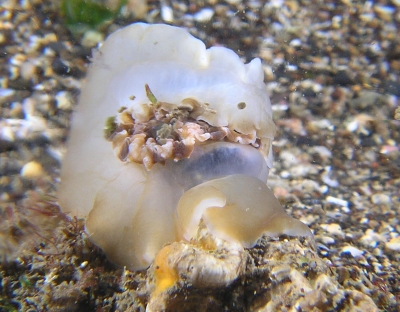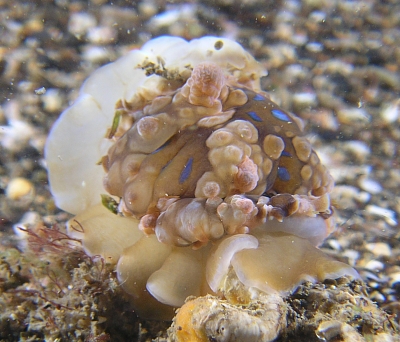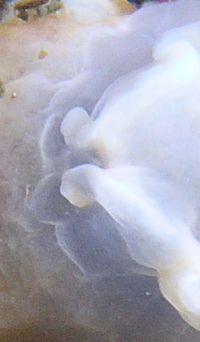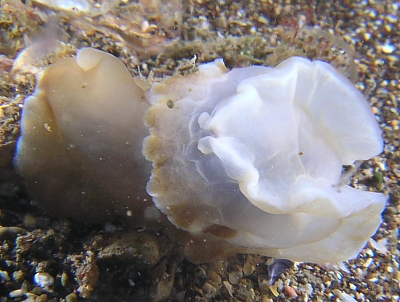Bizarre behavior of Dendrodoris denisoni
June 23, 2006
From: Dong Bum Koh

Dear Bill,
We observed this bizarre behavior of Dendrodoris denisoni during night diving in Jeju island. When we found it the mantle seemed fully inside out, and it only slowly returned to its original posture.
Locality: Hwa Soon , 4m, Jeju Is.. Korea, Pacific, 19 Dec.2004, Sandy. Length: Approx.35mm. Photographer: Sang Yul Shin.
Could you let me know the meanings of behavior?
Best regards,
Dong Bum Koh
drkoh@seasee.co.kr



Dear Koh,
I have seen this behaviour in some dendrodorids when I have been trying to preserve them, but not in the field. As I discuss on the Preservation Fact Sheet, most nudibranchs need to be narcotised or 'put to sleep' before they are preserved, otherwise their muscles contract and they become a shapeless ball which is impossible to dissect. Animals without a solid skeleton to which the muscles can be attached, use the fluid in their body cavity to keep their general shape, but when unnatural contractions occur, the blood can be forced into strange places, and so result in strange shapes. Dendrodorids like D. denisoni seem to have little elasticity in their mantle skin - in fact the mantle seems to lack a muscle layer, so when the mantle contracts, the fluid is forced into the more elastic foot which results in the look you have described and illustrated.
I am not sure why it has happened 'in the wild', but it is possible that the Dendrodoris has been 'mouthed' by a fish and then spat out. Fish often take potential prey into their mouth for testing before chewing or swallowing, and it is possible a fish found it distasteful and spat it out, but in the process digestive or salivary secretions may have irritated its mantle. Another possibility, which I have seen in aquarium situations, is that the slug has come into contact with the feeding tentacles of a sea anemone, and this is its reponse to being stung.
Whatever the reason, some good has come of the situation, because you have taken an excellent photo of a dendrodorid head [see close-up photo], which is quite different from the head of most other dorids [see Dorid head Fact Sheet ]. Dendrodorids do not have a 'snout' or a pair of oral tentacles. They have a pair of flaps which run from the foot up on each side of the mouth to form a little 'box' around the pore-like mouth. Dendrodorids do not have any radular teeth, so they feed by secreting digestive juices out on to the sponge they are feeding on. The sponge tissue is then half digested into a 'sponge soup' which the dorid can then suck in. However, this can't take place in the open sea or the juices would be quickly diluted by the surrounding sea water. Unfortunately we can't actually see what's happening when they are feeding, but I think these flaps are there to form a seal around the mouth and the sponge, to enclose the digestive processes which are occurring outside the body.
Best wishes,
Bill Rudman
Related messages
-
Re: Dendrodoris denisoni or D. gunnamatta
From: Atkinson, L. & D., November 12, 2009 -
A species of Halgerda?
From: Nick Chapman, August 18, 2009 -
Re: Dendrodoris denisoni from Sydney
From: Jessica Herder, August 1, 2008 -
Dendrodoris denisoni from South Africa
From: Peter Small, April 11, 2008 -
Dendrodoris denisoni from Rockingham WA
From: Mick Tait, August 13, 2007 -
Another Dendrodoris denisoni from Thailand
From: Mr Philip Mason, April 13, 2007 -
Dendrodoris denisoni from Thailand
From: Mr Philip Mason, April 12, 2007 -
Dendrodoris denisoni from Townsville, Queensland
From: Melanie Wood, December 12, 2006 -
Dendrodoris denisoni from Bali, Indonesia
From: Stefan Harrieder, May 28, 2005 -
The eggs of Dendrodoris denisoni in S. Korea
From: Dong Bum Koh, May 10, 2005 -
Dendrodoris denisoni from Singapore
From: Lim Han Peng, April 22, 2005 -
Dendrodoris denisoni from Reunion island
From: Philibert Bidgrain, February 22, 2005 -
Dendrodoris denisoni from Northern NSW
From: Denis Riek, March 15, 2004 -
Dendrodoris denisoni from New Zealand
From: Mark Burnett, January 8, 2004 -
Dendrodoris denisoni from Thailand
From: Nat Yisunsri, July 11, 2003 -
Dendrodoris denisoni from Indonesia
From: Tony White, May 23, 2003 -
Dendrodoris denisoni and starfish
From: Dong Bum, Koh, February 21, 2003 -
Dendrodoris denisoni from New Zealand
From: Mark Burnett, February 21, 2003 -
Dendrodoris denisoni from Chek Jawa, Singapore
From: Ria Tan, January 30, 2003 -
Dendrodoris denisoni from Port Stephens
From: Allan Saben, January 17, 2003 -
Dendrodoris denisoni from New Zealand
From: Ian Simpson, December 12, 2002 -
Dendrodoris denisoni from Taiwan
From: Connie, August 15, 2002 -
Dendrodoris denisoni from Hawaii
From: Rita Bishop, July 16, 2002 -
Hoplodoris?? from the Philippines
From: Erwin Koehler, November 14, 2001 -
Behaviour of Dendrodoris denisoni in New Zealand
From: Liz Buckley, September 24, 2001 -
Juvenile Dendrodoris denisoni from Queensland
From: Nerida Wilson, June 8, 2001 -
Dendrodoris denisoni from Port Stephens
From: Stuart Hutchison, August 19, 2000 -
Dendrodoris denisoni or D. gunnamatta
From: P.Zylstra & H.Rothenfluh, June 22, 2000 -
Dendrodoris denisoni from South Africa
From: Valda Fraser, April 19, 2000 -
Dendrodoris denisoni from Sydney
From: Stephanie Clark, January 3, 2000 -
Dendrodoris denisoni from New Zealand
From: Ross Armstrong, December 13, 1998
